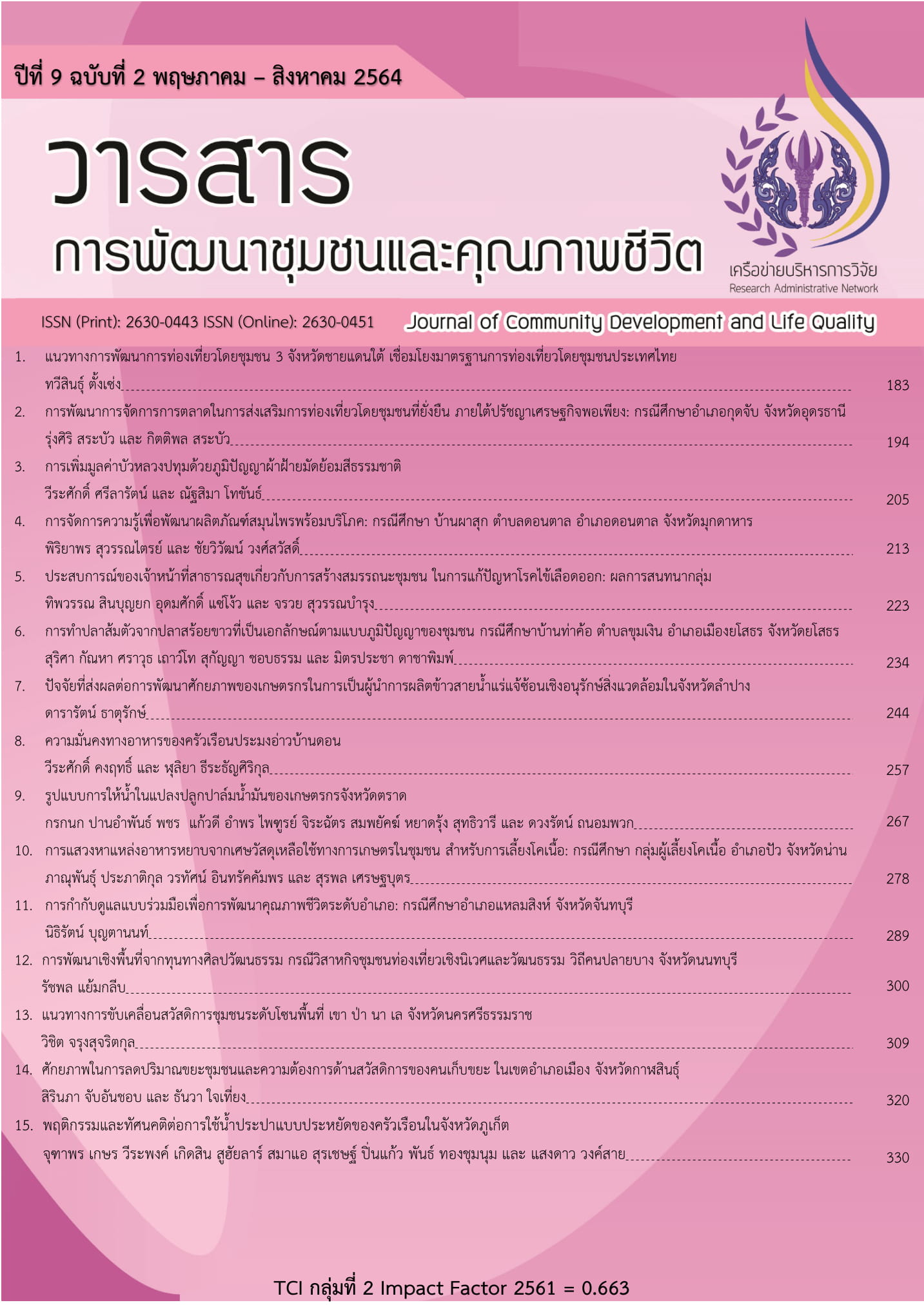แนวทางการขับเคลื่อนสวัสดิการชุมชนระดับโซนพื้นที่ เขา ป่า นา เล จังหวัดนครศรีธรรมราช
Main Article Content
บทคัดย่อ
การวิจัยนี้มีวัตถุประสงค์เพื่อศึกษาแนวทางในการขับเคลื่อน/บูรณาการกองทุนสวัสดิการชุมชนจำแนกตามการแบ่งเป็นโซนพื้นที่เขา ป่า นา เล ในจังหวัดนครศรีธรรมราช ซึ่งการวิจัยนี้เป็นการวิจัยแบบผสม โดยใช้การสุ่มตัวอย่างแบบแบ่งชั้นจากสมาชิกกองทุนสวัสดิการชุมชน 394 คน และการสนทนากลุ่มโดยตัวแทนกลุ่ม จำนวน 25 คน ผลการศึกษาพบว่า กิจกรรมการขับเคลื่อนสวัสดิการชุมชนแบบโซนพื้นที่ มีกระบวนการเรียนรู้ในรูปแบบเครือข่ายระดับโซนมากที่สุด แล้วมีการยกระดับการพัฒนาขยายผลและเชื่อมโยงไปสู่ประเด็นอื่น ๆ ผ่านกิจกรรมสวัสดิการต่าง ๆ นำไปสู่คุณภาพชีวิตที่ดีขึ้น จึงได้มีการเปรียบเทียบตัวแปรระดับความคิดเห็นต่อกิจกรรมการขับเคลื่อนสวัสดิการชุมชน จำแนกโซนพื้นที่ โดยการเปรียบเทียบแบบ One way ANOVA และการเปรียบเทียบพหุคูณด้วยวิธี LSD พบว่า ตัวแปรที่มีความแตกต่างกันอย่างมีนัยสำคัญ จำนวน 15 ตัวแปรจากทั้งหมด 19 ตัวแปร จากนั้นนำตัวแปรดังกล่าวมาร่วมกับการวิเคราะห์ข้อมูลเชิงคุณภาพ โดยการศึกษาเชิงคุณภาพเพื่อหาแนวทางการขับเคลื่อนจากภาพรวมระดับจังหวัด ได้แบ่งการขับเคลื่อนระดับพื้นที่ในระดับโซนพื้นที่เขา ป่า นา เล และชุมชนเมือง เป็น 5 พื้นที่ซึ่งมีความแตกต่างกัน โดยแต่ละโซนพื้นที่ได้มีการบริหารจัดการกองทุนให้เหมาะกับบริบทและการมีส่วนร่วมที่สอดคล้องกับการคิดเห็นของสมาชิกในด้านต่าง ๆ จากนั้นได้มีการสร้างพื้นที่ต้นแบบแล้วยกระดับขยายผลและมีการสื่อสารรูปธรรมความสำเร็จ รวมทั้งมีการเชื่อมโยงกันเครือข่ายเข้าด้วยกัน
Article Details
กองบรรณาธิการขอสงวนสิทธิ์ในการตรวจและแก้ไขบทความที่เสนอเพื่อตีพิมพ์ในวารสารการพัฒนาชุมชนและคุณภาพชีวิต
บทความหรือข้อความคิดเห็นใด ๆ ที่ปรากฏในวารสารการพัฒนาชุมชนและคุณภาพชีวิต เป็นวรรณกรรมของผู้เขียนโดยเฉพาะคณะผู้จัดทำไม่จำเป็นต้องเห็นด้วย และไม่ใช่ความรับผิดชอบของมหาวิทยาลัยและคณะผู้จัดทำ / บรรณาธิการ
เอกสารอ้างอิง
Alcock, P. 2000. Informal care and the new welfare mix. Social Work Around the World. Switzerland: International Federartion of Social Worker (IFSW).
Aparkorn, P. 2011. The roles of microfinance in promoting financial access. Fiscal Policy Office. Ministry of Finance. (In Thai)
Chandarasorn, V. 2008. An integrated theory of public policy implementation. The Association of Researchers of Thailand. Bangkok. (in Thai)
Chantavanich, S. 2008. Qualitative research methods. Chulalongkorn University Press, Bangkok. (in Thai)
Community Organizations Development Institute. 2014. Summary of the project of the community welfare year 2014. (Online). Available: http://www.codi.or.th/welfare/ (January 16, 2014). (in Thai)
Creswell, J.W. 2015. A concise introduction to mixed methods research. Sage Publications. Thousand Oaks, C.A.
Dechochai, U. 2016. Education evolution community welfare fund to the welfare state: A case community welfare fund Nakhon Si Thammarat province. Narkbhut Paritat Journal of 8(1): 21-29. (in Thai)
Kumhom, R. 2004. Social areas of people and community welfare. Journal of Social Work 12(1): 123 - 136. (in Thai)
Kiratikobmanee, K. and K. Keawvichai. 2017. An effectiveness of integrated urban welfare management model. Journal of Veridian, Silpakorn University 10(2): 252-265. (in Thai)
Krejcie, R.V. and D.W. Morgan. 1970. Determining sample size for research activities. Educational and Psychological Measurement 30: 607-610.
Parinyasutinun, U. 2018. Community welfare: Balancing between giving and taking. Journal of Community Development and Life Quality 4(3): 327 - 336. (in Thai)
Phibulsiri. C. 2008. Factors related to the effectiveness of social welfare project in the community organizations. NIDA Development Journal 48(1): 57-84. (in Thai)
Polit, D.F. and B.P. Hungler. 2004. Nursing research: Principles and methods. Lippincott Williams & Wilkins, Philadelphia.
Wasi, P. 2004. Integrated and sustainable development by setting the area as a location for peace and happiness in every village, every district and every province. Journal of Language and Culture 23(1): 5-14. (in Thai)
Vichai, P. and P. Phonngam. 2016. A research and development of driving mechanism for community welfare: A case study in Thapho sub-district, Muang district, Phitsanulok province. Journal of Humanities and Social Sciences 7(1): 103-127. (in Thai)
Yunus, M. 2007. Creating a world without poverty: Social business and the future of capitalism. New York: Public Affairs.


